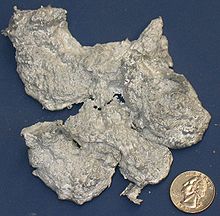Aluminium oxide
Aluminium oxide, also known as aluminum oxide, is a chemical compound made from aluminium and oxygen. Its chemical formula is Al2O3. It is a normally white, powdery solid. It does not exist in a particular form. It can dissolve in acids and bases. It is used as an abrasive (sandpaper is an abrasive). It comes in bauxite and corundum. It does not melt easily. It is dissolved in a cryolite melt and electrolyzed to make aluminium.

Natural occurrence
Corundum is the most common naturally occurring crystalline form of aluminium oxide.[1] Rubies and sapphires are types of corundum. The reason why they have different colors is because there are other elements in it.[2][3]
Properties

Al2O3 is an electrical insulator but it has a high thermal conductivity (30 Wm−1K−1).[4] Aluminium oxide is insoluble in water. Its most common occurring crystalline form, called corundum or α-aluminium oxide.
Aluminium oxide is the reason why aluminium cannot corrode. When aluminium reacts with atmospheric oxygen, a thin layer of aluminium oxide (4 nm thickness) forms on any exposed aluminium surface.[5] This layer protects the metal from more oxidation.
Aluminium oxide is an amphoteric substance, meaning it can react with both acids and bases, such as hydrofluoric acid and sodium hydroxide.
